Efficiency Improvements - 2015
September
What Goes Into a NIF Shot?
What does it take for the world’s largest laser facility to increase its annual production by 50 percent from one year to the next?
The obvious answers—hard work, dedication, teamwork—are all involved, but there’s more: innovations in operational efficiency, new technologies, and the carefully planned execution of tasks based loosely on the interactions of Formula One race car pit crews.
What goes into each NIF shot is a prime example of what planning and communication within and among teams with specialized areas of expertise can accomplish.“The entire NIF team got behind the goal.”
“Reaching our Fiscal Year 2015 goal of 300 target shots on Aug. 13—more than six weeks before the end of the year—is a testament to the commitment of the NIF Team and the broader NIF community to increase the rate at which the programs conduct experiments and acquire data on the facility to make progress on their missions,” says Operations Manager Bruno Van Wonterghem. NIF’s overarching mission is Stockpile Stewardship, with a goal of maintaining the safety and reliability of the U.S. nuclear deterrent without testing. NIF shots also support High Energy Density Science, Ignition Science, Discovery Science, and National Security Applications.
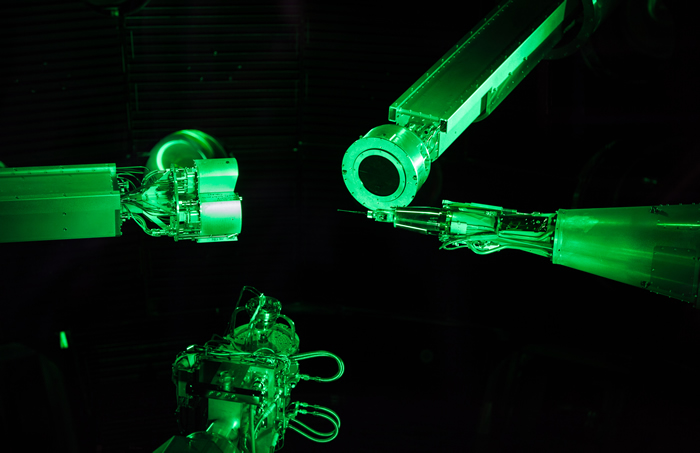 Diagnostics for a National Security Applications system generated electromagnetic pulse experiment, inserted in the NIF Target Chamber. The target positioner is on the right. Photos: James Pryatel
Diagnostics for a National Security Applications system generated electromagnetic pulse experiment, inserted in the NIF Target Chamber. The target positioner is on the right. Photos: James Pryatel NIF shot operations are conducted around the clock five days a week, from 6:30 a.m. Sunday to 6:30 a.m. the following Friday. Planning and scheduling a shot takes place weeks, even a month or more before the shot. On the day of a shot, the NIF Team executes hundreds of tasks to install the target and deploy the diagnostic equipment that ensures that the results of each experiment are captured and recorded.
Technical teams have fabricated the target and readied the diagnostics weeks in advance, but both have to be installed the day of the shot. And the two “off” days, Friday and Saturday, are not truly off—they’re used to maintain the facility and the laser. NIF is a beehive of activity 24 hours a day, seven days a week.
A day in the life of NIF
At 6:30 a.m., the day shift arrives for work. Fifteen minutes later, the night shift hands over operations to the day shift at the pre-shift meeting. The shot director briefs the shot operations team on the plan for the day, and the next shot’s responsible individual (RI)—usually the scientist who planned the research behind the shot—briefs the team on the experiment’s scientific goals.
A dozen or more key NIF staff members attend the daily operations staff meeting at 9 a.m. They review a detailed schedule of the tasks planned for the day’s two to three shots, as well as those for the week ahead, including shot set-up and recovery, maintenance, and requests for modifications to the schedule.
Meanwhile, most of NIF’s staff has been busy either finishing up a previous shot, or prepping for the next one.
The R&R meeting
Rest and relaxation? No, quite the opposite. The R&R (recovery and reconfiguration) meeting for the upcoming shot, call it shot B, actually happens just before the “previous” shot, shot A, takes place. Here’s why:
A shot lasts just a few billionths of a second, so once the countdown reaches zero, shot A is over faster than anyone can blink. To help minimize the time it takes to move from shot A to shot B, the teams that set up for shot B need to be ready to move in immediately after shot A is completed. At the R&R meeting, the shot director, lead operator, and the team supervisors review a checklist of items required to prep for the next shot. The Target Area supervisor leads the meeting and is responsible for seeing through the execution of the checklist.
Their job is to go over the list of actions that crews will take, making sure that all needed personnel are present and that all the required equipment and parts are available. They also decide on the most efficient recovery sequence. The meeting’s purpose is to ensure that the NIF Target Area team is as prepared as possible to recover from the current shot and set up for the next one as efficiently as possible.
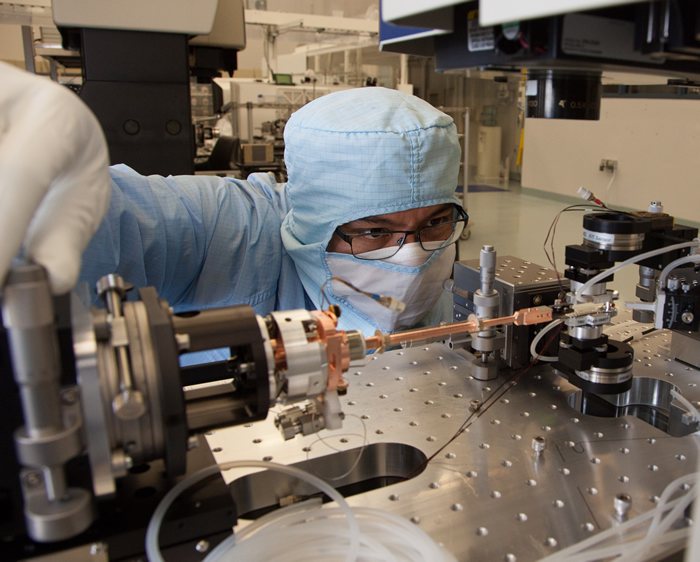 Assembly of a NIF target, the gold hohlraum at the center right of the image, takes place weeks to months in advance of a NIF shot. See “Target Fabrication Steps Up to the Challenges.”
Assembly of a NIF target, the gold hohlraum at the center right of the image, takes place weeks to months in advance of a NIF shot. See “Target Fabrication Steps Up to the Challenges.” At the R&R meeting the watchwords are safety, quality, and efficiency. NIF’s operations staff is well aware that “no increase in shot-rate or efficiency matters if it comes at the expense of safety or the quality of our work,” says Van Wonterghem. “Constant vigilance is required to resist the temptation to go faster by cutting a corner. A working group consisting of a cross-section of staff and management assures good communication and continuous improvement in this area.”
Moving in for the next shot
Once the lead operator has counted down to shot A, and it’s fired, it is time to move in and set up for shot B. A carefully choreographed ballet begins.
After isolating and venting the target positioner (Tarpos), the device that will precisely locate the target at the center of the Target Chamber, to atmosphere, cryogenic target systems team members arrive at the Target Bay and begin installing the new target onto the Tarpos. “It’s all about being prepared,” says Paul Amick, the Cryo Target Systems work center supervisor. Three weeks before a particular shot, Amick had prepared a spreadsheet mapping all the details of the shot—the gas mix inside the two-millimeter-diameter target capsule, the required temperature and pressure, and so on.
The shot B target has been delivered to a staging area near the Target Chamber so it’s ready to go in as soon as shot A is over. Some targets, such as those cryogenically cooled to about 18 degrees Kelvin (minus 426 degrees Fahrenheit) and designed for inertial confinement fusion experiments, require hours to install. Room-temperature targets, used in some Discovery Science and other research, can take as little as a half-hour. Because there can be two to three shots a day, Amick is always in target planning mode for upcoming shots, while supervising the teams that install the next target.
“One of the things that keeps this job fresh for me is the constant change,” Amick says. “Handling the changes required by each successful shot makes me feel like I have helped my team be successful.”
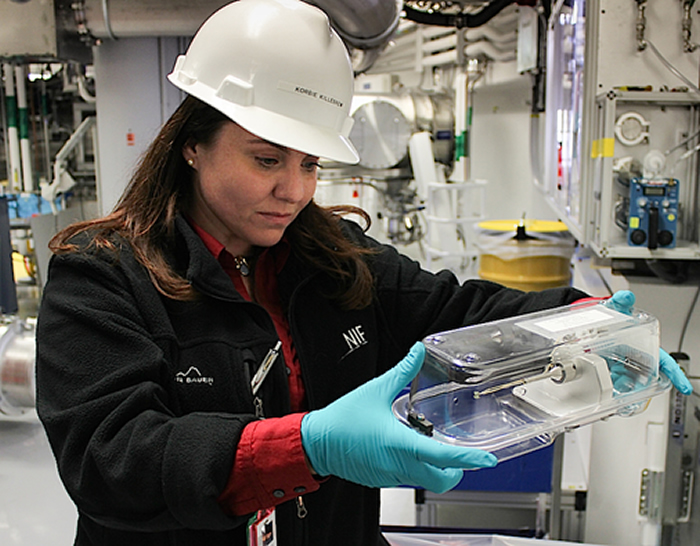 Shot Director Korbie Killebrew verifies the serial number of a target just before installation.
Shot Director Korbie Killebrew verifies the serial number of a target just before installation. Target Area team members work to reconfigure the diagnostics for shot B while recovering some of the data from shot A. Although much of the data is collected electronically, a few diagnostics produce film or image plates that must be collected and sent for processing. When requested by the shot RI, this team also reconfigures the final optics for a particular shot.
Mark Wilson, the Target Area work center supervisor, meets with his field supervisor first thing in the morning, and then participates in the pre-shift, R&R, and daily operations meetings. He reviews the schedule of work for the shots and schedules the work teams for the most efficient reconfiguration plan. A Target Area field supervisor is in the thick of reconfiguration, making sure that every task is completed safely, efficiently and correctly.
The Target Diagnostics Operations team then arrives to reconfigure the diagnostic equipment that measures and records data for the next shot. “Many diagnostics are standard to each shot,” says Brandi Lechleiter, the Target Diagnostics work center lead. “A few require physical set-up.” NIF has a toolkit of about 60 different diagnostics, capable of a variety of optical, x-ray, and nuclear measurements.
 Many specialized instruments—detectors, oscilloscopes, interferometers, streak cameras, and other diagnostics—surround the target chamber to measure the system’s performance and record experimental results. By characterizing the x rays generated during NIF experiments, the Dante soft x-ray power diagnostic, shown here, helps scientists understand how well the target performed.
Many specialized instruments—detectors, oscilloscopes, interferometers, streak cameras, and other diagnostics—surround the target chamber to measure the system’s performance and record experimental results. By characterizing the x rays generated during NIF experiments, the Dante soft x-ray power diagnostic, shown here, helps scientists understand how well the target performed. Installing the diagnostics
Lechleiter’s teams of Target Diagnostic operators configure the diagnostics specific to a particular shot, while Wilson’s Target Area operators install preconfigured hardware onto the diagnostics. Target Area personnel in the Target Diagnostics Factory, who prepared the equipment in advance, have already placed the hardware in a nearby staging area. “We’ve built the diagnostic according to the specifications in a work order at least a week in advance,” says Justin Wright. “Diagnostics for Sunday shots are ready the previous Thursday. All the rest of the week’s diagnostics are ready by Friday.”
Two Target Diagnostic operators per team per shift have up to four hours to implement the diagnostics reconfiguration. Equipment problems can happen, but they are rare. Lechleiter gets job satisfaction from “seeing things progress, and get better, and I like seeing us get better at what we do.”
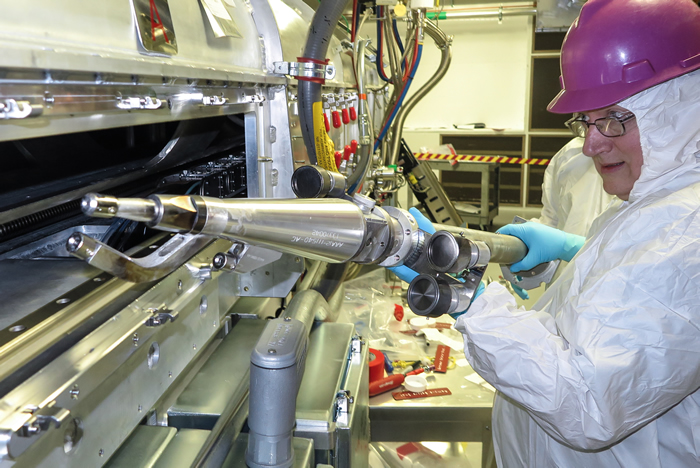 Target Area Operator Steve Keesee installs a diagnostic snout onto an instrument mounted in the diagnostic instrument manipulator during shot reconfiguration.
Target Area Operator Steve Keesee installs a diagnostic snout onto an instrument mounted in the diagnostic instrument manipulator during shot reconfiguration. Not everything happens simultaneously. NIF’s operations team has coordinated a sequence of work to avoid the possibility that one team will get in the way of another in the sometimes tight spaces where equipment has to be switched out.
After several hours of work, with actual time varying from about four to 12 hours depending on the specific steps of the reconfiguration and the complexity of the shot, the field supervisors verify that their crews have completed all their tasks. Next, they join the operations staff in the R&R meeting, getting ready for shot C.
The lead operator requests a “sweep” of the facility to ensure that no one is left behind in the operational areas. The Target Area supervisor oversees the sweeps of the Target Bay floors and declares the Target Area ready for Control Room operations to take over. “For me, it’s satisfying to know that we can do hundreds of transactions per week, work safely, and give the customers (the scientists) what they want,” Wilson says.
Efficiencies include streamlining—and quality focus
Many of the efficiency and scheduling improvements that have contributed to NIF’s heightened productivity were recommended by a recent “120-day Study” tasked by the U. S. Congress with finding ways to enhance NIF’s shot availability over three years at a constant annual funding level. Matt Cohen, senior field supervisor for Target Area Experimental Operations, says that reducing the number of steps to finish the complicated process of setting up shots was one of the keys to NIF’s hitting its 300-shot goal this year: “We streamlined old, cumbersome procedures to gain efficiencies.”
To illustrate, Wilson tells the story of streamlining checklists: “We took a second look at the checklists we use in the field. Knowing that we had proficient operators who understood the procedures, we were able to reduce the length of some of the checklists to as little as 25 percent of the originals.”
Conversion to the interactive electronic checklists known as NEO, or NIF Electronic Operations, also contributed significantly. In many cases operators use simple notepads rather than thick paper checklists.“Grouping shots together into ‘mini-campaigns’ is another significant facility operational use improvement.”
Another improvement, paradoxically, was making sure the work crews were not rushed. “Our role as supervisors is to ensure that we don’t plan more work for crews than they can reasonably accomplish safely,” says Cohen. By providing enough time to perform high quality work without rushing, the crews get things right the first time without safety lapses.
“No single change stands out as the primary improvement responsible for the dramatic improvement in shot-rate,” says NIF Facility Manager Doug Larson. “Instead, it was the fact that the entire NIF team got behind the goal. Every member of the team understood what we were trying to do, and applied his or her own expertise and creativity to come up with ways to make things go faster or more efficiently in his or her area.” Last month LLNL Director Bill Goldstein recognized the work of the NIF Shot Rate Improvement Team with a 2015 Director’s Institutional Operational Excellence Award.
The Control Room takes over
Now the shot cycle is ready to begin. About 14 Control Room operators configure and align multiple laser and diagnostic systems. Overseeing all of this work in the Control Room are the lead operator and the shot director. Duty engineers load software-based diagnostics in the configuration specified for the shot. The Target Area coordinator begins to control the placement of DIMs, the diagnostic instrument manipulators that hold diagnostics close to the target. DIMs jut into the Target Chamber through specially designed ports. The diagnostics they hold need to be positioned close to the target—exactly where depends on the experiment and what the diagnostic is designed to measure.
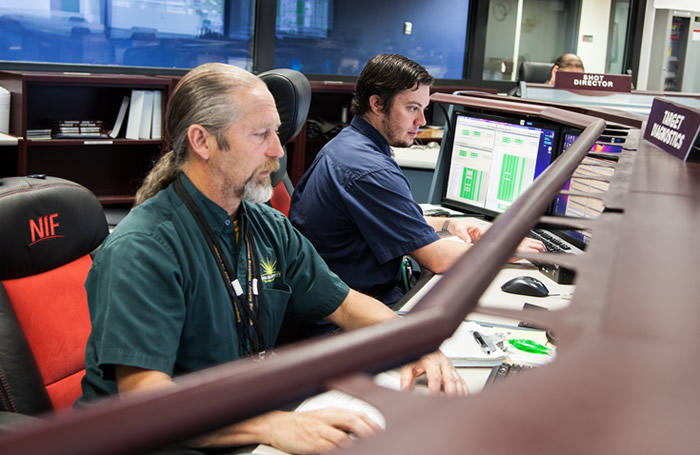 Target diagnostics operators Karl Pletcher (left) and Scott Rogers review the status of diagnostics for an upcoming shot in the NIF Control Room.
Target diagnostics operators Karl Pletcher (left) and Scott Rogers review the status of diagnostics for an upcoming shot in the NIF Control Room. Once the DIMs are aligned, Beam Control System operators position the target alignment sensor at the Target Chamber center and start the process of pointing 192 laser beams and aligning the target at the desired location. The beams and target must be positioned to within about 50 microns—about half the width of a human hair—of the exact point within the chamber where NIF’s beams converge on the target. Target Area alignments can take one to two hours or more; this typically is the critical path to completing the shot. (For more on Beam Control operations, see “Lisa Burrows: From Wisconsin to Beam Control.”)
Meanwhile, aligning and configuring laser systems and laser diagnostics in NIF’s two laser bays proceeds in parallel with Target Area alignments. Injection Laser System operators configure the Master Oscillator Room, the 48 preamplifier modules, and the diagnostics for each of the 192 laser beams. Industrial Control Systems operators prepare several utility systems. Power Conditioning System operators configure the charging supplies that will fire the flashlamps in the main and power amplifiers and confirm that the laser optical switches called plasma electrode Pockel cells are ready for laser operation. “Preparing the laser beams, diagnostics, utilities, Target Area, and the facility for a shot is a complicated but well-choreographed sequence of events,” says Steve Weaver, NIF’s shot operations manager.
“Improved planning, scheduling, and coordination have been crucial to achieving 300 shots this year.”
When all the alignments and system configurations are completed, it’s time for a “rod shot”—a low-energy test shot without the main and power amplifiers to verify that everything is working. If all is well, the target alignment sensor is retracted from the Target Chamber and the target positioner and DIMs are returned to their shot positions, ready for the actual shot. The lead operator then conducts a roll-call of all Control Room operators. When all operators reply “ready,” the lead operator starts the four-minute countdown clock. When the clock reaches T-zero, NIF’s complex control system automatically fires the shot and acquires all the target and laser data. View the Countdown Video
NIF’s Integrated Computer Control System (ICCS), one of the world’s most sophisticated computer control systems, monitors some 66,000 control points using 3.5 million lines of code running on 2,000 computers, making it possible to fire NIF’s 192 lasers efficiently and reliably several times a day. Significant code improvements were made to speed up the duration of the ICCS shot cycle and make it easier for operators to do their jobs.
Next batter up
The shot is over almost as soon as it’s begun. From the Control Room, operators pull out the DIMs and the target positioner, verify that data were collected properly, and archive it. The flashlamps that drive the lasers must be cooled for about an hour before the next shot. In very high-energy shots, an ultra-high-resolution camera called the final optics damage inspection system, or FODI, scans the laser optics from inside the Target Chamber looking for any problems. NIF’s operations crews reorganize, and the set-up process repeats for the next shot…
…or not—if the next shot is very similar, much less set-up is required. “Grouping shots together into ‘mini-campaigns,’ sets of shots with similar requirements and scientific objectives, is another significant facility operational use improvement that helped boost the number of successful NIF shots this year and helped experimenters improve campaign efficiency,” according to Van Wonterghem.
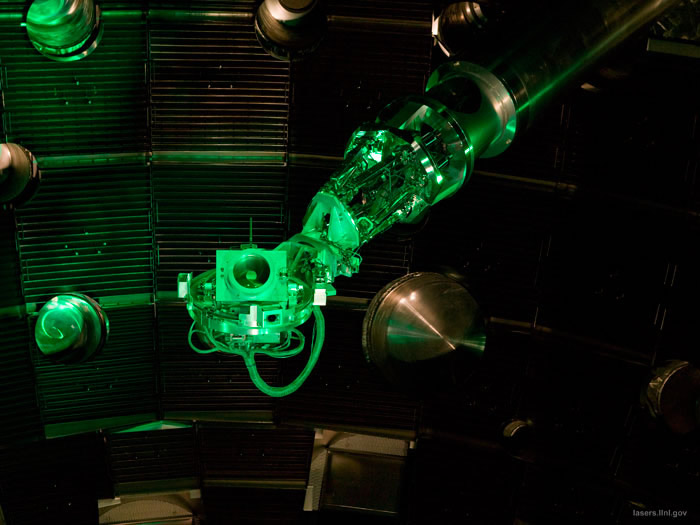 NIF’s Final Optics Damage Inspection System, when extended into the Target Chamber from a diagnostic instrument manipulator, can produce high-resolution images of all 192 beamline final optics assemblies.
NIF’s Final Optics Damage Inspection System, when extended into the Target Chamber from a diagnostic instrument manipulator, can produce high-resolution images of all 192 beamline final optics assemblies. “Improved planning, scheduling, and coordination have been crucial to achieving 300 shots this year,” says Weaver.
Time flies. It’s 6:30 p.m., and the night shift has arrived for work. Fifteen minutes later, they’re in the evening pre-shift meeting—getting ready to continue NIF’s important work deep into the night.




